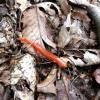-
Posts
33 -
Joined
-
Last visited
Profile Information
-
Location
Pennsylvania
-
Interests
Fly fishing, hiking, literature, poetry, hockey, philosophy, whiskey
Recent Profile Visitors
892 profile views
alatos's Achievements

Pleurotus Junior Member (2/5)
-
These do not look like mica cap to me.
-

What are your top 3 reasons for mushroom hunting?
alatos replied to alenameadollar's topic in General Mushroom Discussion
I'll preface by saying that I'm only a few years into regular mushroom hunting... I think this will be my fifth season where I'll go out regularly (foraging plants as well). 1. The connection with nature and our hunter-gatherer past 2. The flavor and interesting recipes that get opened up with different species of mushroom (I just picked up this book, for instance, and it has me really excited for the season) 3. The health benefits of walking, eating mushrooms, and being in nature. Plus, my wife is pretty into it too, at this point. She's as excited as I am for morel season. -
Thank you, svs. I've read very mixed reviews on brick cap flavor, so I don't think I'll actually be eating these. Just wanted to get a second opinion on the ID.
-
Found these on a decaying hardwood stump in PA. Dark purple/greyish spore print. Anything these might be besides brick caps?
-
I had no idea. I will contact the NJMA before I got back to make sure I'm not breaking any laws.
-
Thank you both. Dave, I actually found these in the NJ pine barrens. I went on a camping trip there with my wife after reading John McPhee's book, and it was a cool place. We'll definitely be going back, and taking our baskets. We saw quite a few American persimmons, too, which were almost all unripe.
-
Actually, I am thinking this is Aureoboletus projectellus.
-
Found these hiking the pine barrens, growing under pine and white cedar. I'm having no luck identifying them with my field guides. They definitely seem like a distinctive species, so I'm hoping someone can help me out. Pores do not stain.
-
Agreed, these look like Lactarius of some kind to me. I don't think the photos show the same species. The mushrooms in the first photo seems to have different color gills and cap. It's impossible to tell based on the photo, but it looks like the first photo could be a far-past-prime Lactarius volemus. That's just an idea, though, and I'm no expert.
-
Thanks, Dave. Lanmaoa pseudosensibilis looks possible, for sure. Either way, I'm not going to eat these. And yes, funny enough the track was very close by—maybe 15 yards from the trumpets.
-
Boletus pallidoroseus is one guess on these, but I'd be curious what you all think. Found in mixed hardwood in Pennsylvania. I know bicolor boletes grow in the area, but these two do not seem very bright red or yellow... maybe because they're dry or aged? When I cut down the cap and stem, the flesh is yellow, slowly staining light blue in spots, but not entirely, and barely any staining through the stem. I see that Boletus pallidoroseus smells like bouillon. I'm not sure... these definitely have a nice scent, and I could describe it as bouillon-like, but that could just be the power of suggestion. Also including some trumpets, chanterelles, and the bigfoot track I came across, because why not?
-
Hedgehogs are another rare one... I found one maybe the second time ever mushroom hunting and left it because I didn't know what it was! Deal.
-
I've been mushroom hunting pretty frequently for about three seasons now in southeastern PA. I've had pretty good luck with a good variety of mushrooms, but there are some that I "should" be seeing that I just don't find. For one, lobster mushrooms. Never seen a single one in three years. Another is black trumpets. I have found some small flushes of these, but not like many mushroom hunters seem to experience. Not complaining, because I do find good numbers of chanterelles, morels, chicken, maitake, honeys, and other delicious edibles. Are there any species that you all find very rare or absent from your area?
-

Bicolor bolete turning bright orange when cooked??
alatos replied to alatos's topic in General Mushroom Discussion
Hmmm.. yep, knowing that this doesn't look like bicolor. Unfortunately, just not sure at this point. -

Bicolor bolete turning bright orange when cooked??
alatos replied to alatos's topic in General Mushroom Discussion
That's comforting to hear. I'm still going to err on the side of caution and chuck the ones that turned orange, but at least I feel a little better about my ID skills haha. I was sure they were bicolors before cooking, but when they turned color, I started second guessing myself big time. Just never saw this before, but it's not like I harvest boletes too often anyways.
























